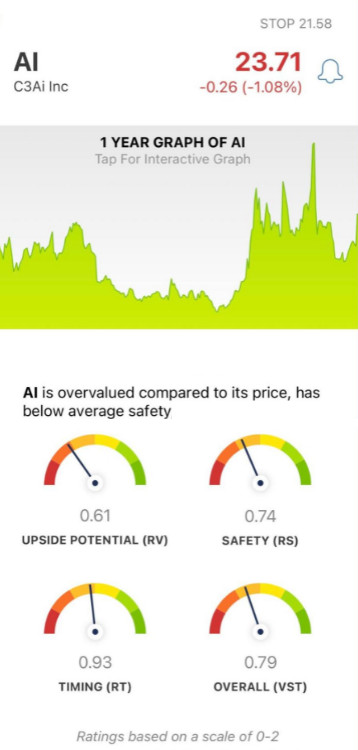Integrity and compatibility are two of the primary aspects to take into consideration when looking at AI software for stock forecasting and analyzing trading platforms. A platform that seamlessly integrates with existing processes, tools and systems of your company can increase efficiency and productivity. Here are the 10 best ways to evaluate the compatibility and integration of these platforms.
1. Check Brokerage Integration
Supported Brokers: Check that the platform you choose to use is compatible with your favorite brokerage account or trading platform.
Trade execution: Check whether your platform permits you to execute trades directly via the integrated broker.
Account synchronization: Make sure that the platform can update in real-time account balances and positions as well as transaction history.
2. Check the API's availability
API access - Ensure that the platform comes with an API that allows developers to develop customized tools or automate workflow processes.
API documentation: Make sure the documentation for the API includes clear examples and examples of use.
Rate Limits: Check the API's rate limits to confirm that they are appropriate and can handle your anticipated use.
3. Integrating Third-Party Tools
Popular Tools: Make sure the platform integrates with other applications, like Google Sheets and Excel.
Export and import of data: Ensure that the platform supports easy export and import of data to and from other tools.
Plugins/extensions: Verify if the platform can support plugins or extensions for additional capabilities.
4. Test Compatibility With Operating Systems
Desktop compatibility is essential. Check that your platform will work on the operating system you prefer (Windows MacOS Linux).
Mobile compatibility. Verify if you are able to download the app using iOS or Android.
Web-based access: Check that the platform can be accessible via a web browser to allow for greater flexibility.
5. Analyze Data Integration Capabilities
Data sources: Check that the platform integrates with multiple data sources (e.g. market data sources or news feeds).
Real-time Data Feeds: Check to see if your service provides real-time analysis.
Check the platform's ability to import old data.
6. Assess cloud and On-Premise Compatible
Cloud-based Platforms: The platform must be accessible anywhere there is an internet connection.
On-premise Solutions: If you would like to run your application on premises ensure that your platform is compatible.
Hybrid models: Find out whether the cloud-based platform integrates and on-premise capabilities.
7. Make sure to check for Cross Platform Synchronization
Device synchronization. Make sure the platform is synchronized to transfer settings and data across devices (desktops/laptops/mobiles/tablets).
Real-time updates: Verify if any changes made on one device reflect immediately on others.
Access offline: Check whether your platform provides restricted functionality and access to data while offline.
8. Examine the compatibility of trading Strategies
Algorithmic trading: Make sure that the platform you choose supports automated or algorithms trading strategies.
Custom indicators: Determine whether you are able to utilize customized indicators or scripts.
Backtesting strategies: Find out if the platform supports backtesting of trading strategies using historical data.
9. Examine Security and Compliance
Data encryption: Ensure that the platform has encryption in place for data in transit and in rest.
Authentication Check if the platform supports secure methods of authentication (e.g. Two-factor authentication).
Regulative compliance: Make sure that the platform is in compliance with relevant regulations.
10. Test Scalability Performance
Scalability - Make sure the platform you choose can meet your ever-growing demands in terms of both users and data.
Performance during load: Verify whether the platform performs as expected in high-volatility situations.
Resource usage: Verify that the platform is using system resources efficiently (CPUs memory, CPUs, bandwidth).
Bonus Tips
User feedback: Review user testimonials and reviews to assess the platform's ability to integrate.
Free trial period: You can use a demo or free trial to check the platform's compatibility with your existing workflows and applications.
Customer Support: The platform should provide solid support when it comes to integration issues.
Follow these tips to assess the compatibility and integration between AI platforms for stock prediction and analysis as well as your current trading systems and ensure that they increase your trading effectiveness. Check out the top get more info on ai stock trading bot free for blog examples including ai invest, best ai etf, ai investing, trading with ai, stock market software, ai stock trading bot free, best ai for trading, stock analysis websites, ai options trading, stock analysis tool and more.

Top 10 Tips On How To Evaluate The Scalability Ai Trading Platforms
Scalability is an important factor in determining whether AI-driven platforms that predict stock prices and trading can handle the increasing demand of users, volume of data and market complexity. Here are the top 10 tips to determine scalability.
1. Evaluate Data Handling Capacity
Tips: Make sure that the platform is able to process and analyse huge datasets.
The reason: Scalable systems need to manage data volumes that are growing without performance degradation.
2. Check out real-time processing capabilities
Check the way the platform handles real-time data streams such as stock prices and breaking news.
The reason trading decisions are taken in real-time, and delays could cause traders to miss out on opportunities.
3. Cloud Infrastructure Elasticity and Check
Tip: Check if your cloud platform (e.g. AWS, Google Cloud or Azure) and is able to dynamically scale resources.
Why: Cloud platform elasticity allows the system's size to change based on use.
4. Algorithm Efficiency
TIP: Check the computational efficiency (e.g. deep-learning or reinforcement learning) of the AI models used for prediction.
Why: Complex algoriths can consume a lot of resources, so optimizing these algorithms is essential to scalability.
5. Examine distributed computing and parallel processing
Find out if the platform uses distributed computing or parallel computing frameworks.
Why? These technologies can speed up data processing across many nodes.
Examine API Integration & Interoperability
Tips Check the platform's capability to integrate with external APIs (e.g., brokers, market data providers, APIs).
The reason: Seamless Integration guarantees that the platform will be able to quickly adapt to new data sources, trading environment as well as other aspects.
7. Analyze User Load Handling
Try simulating high traffic volumes to determine the performance of your platform.
Why: A platform that is scalable must be able to maintain performance even as the number of users increase.
8. Examine the the model's retraining and adaptability
Tip: Examine how often and efficiently AI models are being retrained using new data.
Why: Markets evolve, and models have to change quickly to keep their accuracy.
9. Check for Fault tolerance and redundancy
Tips - Ensure that your system has failover and redundancy mechanisms for dealing with hardware or software failures.
Why: Downtime is costly for trading. So fault tolerance is essential to scalability.
10. Monitor Cost Efficiency
Review the costs associated with your platform that includes cloud's storage, cloud resources and computing power.
What is the reason: The expense of scaling should not be too high. Therefore, it is important to balance performance with costs.
Bonus Tip Future-proofing
Be sure that the platform is able to adjust to changes in regulations and incorporates emerging technologies like quantum computing or advanced NLP.
Concentrating on these aspects will help you evaluate the scalability AI software for stock prediction and trading, and ensure that they are sturdy, efficient and prepared for expansion in the future. Have a look at the top trade ai url for website advice including ai stock market, trading ai, ai stock trading app, trade ai, ai stocks to invest in, ai trading software, ai stock trading app, best ai etf, ai trading tools, stock market software and more.
